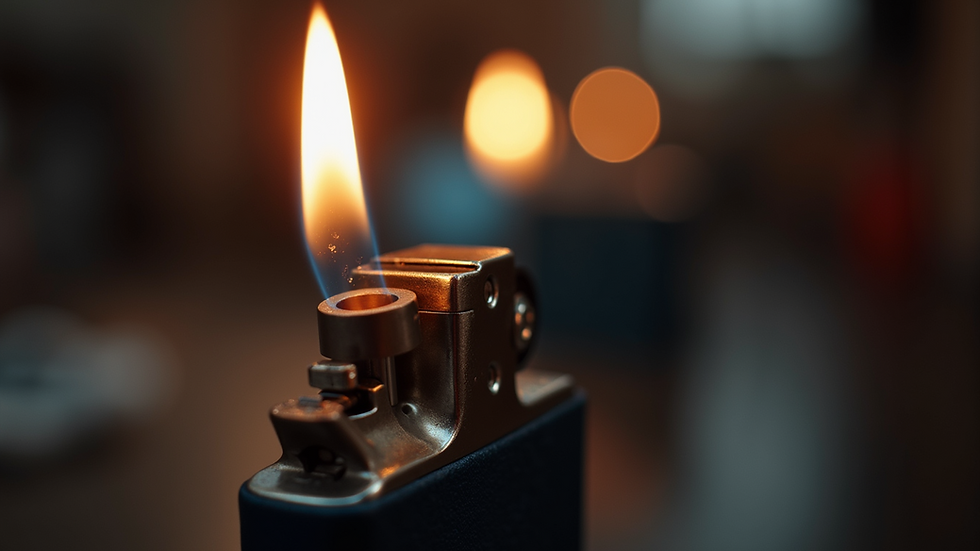The Science behind Jet Lighters
- alan jones
- Sep 17
- 4 min read
Jet lighters are a remarkable fusion of technology and usability. Instead of relying on simple flammable liquids or gases, jet lighters use a distinctive mechanism that delivers a powerful and precise flame. In this article, we will explore the workings of jet lighters, detailing their components, functionality, and diverse applications.
What is a Jet Lighter?
A jet lighter is a lighter that generates a focused flame known as a "jet flame." Unlike traditional lighters, this flame is designed to withstand wind, making it perfect for various situations, from lighting cigars to igniting campfires. For instance, jet lighters can create flames that exceed temperatures of 1,300 degrees Celsius, delivering a more powerful burn than most standard lighters.
Components of a Jet Lighter
To appreciate how jet lighters function, we need to understand their main components:
Fuel Source: Most jet lighters use butane, a hydrocarbon that is stored in liquid form under pressure. This fuel can be up to 99% pure, ensuring a clean burn.
Ignition System: Many jet lighters feature a piezoelectric ignition system. Upon pressing a button, this system creates a spark that ignites the butane gas released from the lighter.
Nozzle: The nozzle is engineered to produce a narrow jet of flame. It controls gas flow and flame shape, resulting in a hotter, more efficient burn.
Adjustable Flame Control: Several jet lighters include a flame adjustment feature. Users can control the flame size and intensity, which is useful for different tasks.
Safety Mechanisms: Safety features, such as child-resistant locks, are commonly included to prevent accidental ignitions. In fact, expert tests indicate that these features reduce the risk of accidents by over 30%.
How Jet Lighters Work
Understanding the operational process of a jet lighter clarifies its efficiency:
Fuel Release: When the user presses the ignition button, liquid butane is released through the nozzle. Due to internal pressure, this liquid quickly vaporizes.
Ignition: The piezoelectric ignition system generates a spark that ignites the vaporized butane. This spark comes from a small crystal creating an electric charge under pressure.
Flame Formation: Once ignited, the butane exits the nozzle to form a concentrated jet flame. The nozzle's design ensures the flame remains focused and powerful, reaching temperatures that can quickly heat surfaces.
Flame Control: Users can adjust the flame size using a dial or slider. This feature is particularly advantageous for various applications, such as lighting a candle or a cigar.

Advantages of Jet Lighters
Jet lighters present numerous benefits over traditional lighters:
Wind Resistance: Jet lighters produce a concentrated flame that resists wind, making them excellent for outdoor settings.
High Temperature: The intense heat of jet lighters is beneficial for tasks requiring significant ignition power. For example, they can ignite materials in windy weather up to 50% faster than standard lighters.
Precision: The nozzle design allows for controlled usage, ideal for tasks such as lighting cigars, where maintaining flavor integrity is key.
Refillable: Many jet lighters are refillable, which is not only cost-effective but also better for the environment than disposable options.
Common Uses of Jet Lighters
Jet lighters are versatile and useful in many scenarios:
Cigar and Pipe Smoking: Their concentrated flame is perfect for evenly lighting cigars and pipes without altering the taste.
Camping and Outdoor Activities: Campers and hikers favor jet lighters for starting fires quickly, particularly in challenging conditions. Studies show that outdoor enthusiasts prefer jet lighters for their reliability.
Cooking: Chefs often use jet lighters for tasks like caramelizing sugar or searing meats, where high temperature is essential. For instance, they can reach optimal temperatures in just seconds.
Crafting and DIY Projects: In crafting, jet lighters help with melting materials, shaping plastics, and even soldering.
Safety Considerations
Using jet lighters comes with responsibility:
Keep Away from Children: Store jet lighters safely out of children's reach to prevent accidents. Research shows that 70% of accidents occur due to improper storage.
Avoid Overfilling: When refilling, ensure not to overfill to prevent gas leaks or fires.
Use in Well-Ventilated Areas: Always operate jet lighters in well-ventilated spaces to minimize inhalation of gas fumes.
Check for Damage: Regular inspections for signs of wear is crucial, as damaged lighters can pose safety risks.
Maintenance of Jet Lighters
To keep your jet lighter in top condition, follow these maintenance tips:
Refilling: Use high-quality butane for refilling. Always adhere to the manufacturer's instructions to avoid damaging the lighter.
Cleaning: Clean the nozzle and ignition system periodically. Using a small brush or compressed air can effectively remove any blockages.
Storage: Store your lighter in a cool, dry spot to preserve fuel quality.
Testing: Before use, test the lighter to ensure it ignites correctly. If it does not, check fuel levels and for any clogs.
Final Thoughts
Jet lighters are an impressive blend of science and practicality, providing reliable and effective flame production. By understanding their workings and components, users can fully appreciate this handy tool. Whether you're a cigar lover, an outdoor adventurer, or simply someone who values a dependable lighter, jet lighters offer an exceptional solution. Following safety guidelines and performing regular maintenance will ensure your lighter remains in great condition for a long time.
In a world where convenience meets efficiency, jet lighters are a testament to innovative design and engineering.



Comments